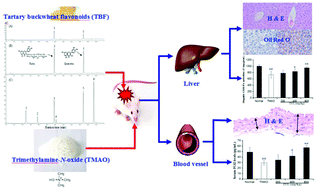Protective effects of tartary buckwheat flavonoids on high TMAO diet-induced vascular dysfunction and liver injury in mice
Abstract
This study was performed to investigate the liver and vascular changes in high trimethylamine-N-oxide (TMAO) diet-fed mice, and the possible vasoprotective and hepatoprotective effects of purified tartary buckwheat flavonoid fraction (TBF). HPLC analysis revealed that the content of rutin and quercetin presented in TBF was 53.6% and 37.2%, respectively, accounting for 90.8% of TBF. Mice fed 1.5% TMAO in drinking water for 8 weeks significantly displayed vascular dysfunction and liver damage (p < 0.01). The administration of TBF at 400 and 800 mg per kg bw significantly elevated plasma NO and eNOS concentrations, and serum HDL-C and PGI2 levels, and lowered serum TC, TG, LDL-C, ET-1 and TX-A2 levels of TMAO-fed mice. TBF also reduced serum AST and ALT activities, and hepatic NEFA and MDA levels, and increased the hepatic GSH-Px and SOD activities in TMAO-fed mice, which were consistent with the observations of the histological alterations of the liver. This report firstly showed that dietary TMAO might cause liver damage and TBF prevented TMAO-induced vascular dysfunction and hepatic injury.


 Please wait while we load your content...
Please wait while we load your content...